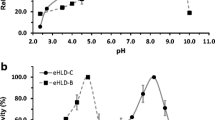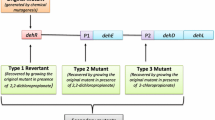Abstract
Dichloroethane (1,2-DCE) is a synthetic compound that is not known to be formed naturally. Nevertheless, several pure microbial cultures are able to use it as a sole carbon source for growth. Degradation of 1,2-DCE proceeds via 2-chloroethanol, chloroacetaldehyde and chloroacetate to glycolate. The genes encoding the enzymes responsible for the conversion of 1,2-DCE to glycolic acid have been isolated. The haloalkane dehalogenase and an aldehyde dehydrogenase are plasmid encoded. Two other enzymes, the alcohol dehydrogenase and the haloacid dehalogenase, are chromosomally encoded. Sequence analysis indicates that the haloacid dehalogenase belongs to the L-specific 2-chloroproprionic acid dehalogenases. From the three-dimensional structure and sequence similarities, the haloalkane dehalogenase appears to be a member of the α/β hydrolase fold hydrolytic enzymes, of which several are involved in the degradation of aromatic and aliphatic xenobiotic compounds.
Similar content being viewed by others
References
Anthony C & Zatman LJ (1967) The microbial oxidation of methanol. Purification and properties of the alcohol dehydrogenase ofPseudomonas sp. M27. Biochem. J. 104: 953–959
Franken SM, Rozeboom HJ, Kalk KH & Dijkstra BW (1991) Crystal structure of haloalkane dehalogenase: an enzyme to detoxify halogenated alkanes. EMBO J. 10: 1297–1302
Frantz B, Ngai KL, Chatterjee DK, Ornston LN & Chakrabarty AM (1987) Nucleotide sequence and expression ofclcD, a plasmidborne dienelactone hydrolase gene fromPseudomonas sp. strain B13. J. Bacteriol. 169: 704–709
Greer CW, Baumier D & Samson R (1989) Application of on-line sensors during growth of the DCE degrading bacteriumXanthobacter autotrophicus. J. Biotechnol. 12: 261–274
Gschwend PM, Macfarlane JK & Newman KA (1985) Volatile halogenated organic compounds released to seawater from temperate marine macroalgae. Science 227: 1033–1035
Hardman DJ & Slater JH (1981) Dehalogenases in soil bacteria. J. Gen. Microbiol. 123: 117–128
Horn JM, Harayama S & Timmis KN (1991) DNA sequence determination of the TOL plasmid (pWWO)xylGFJ genes ofPseudomonas putida: implications for the evolution of aromatic catabolism. Mol. Microbiol. 5: 2459–2474
Janssen DB, Scheper A & Witholt BW (1984) Biodegradation of 2-chloroethanol and 1,2-dichloroethane by pure bacterial cultures. In: Houwink EH & Van der Meer RR (Eds) Innovations in Biotechnology, pp 169–178. Elsevier, Amsterdam
Janssen DB, Scheper A, Dijkhuizen L & Witholt B (1985) Degradation of halogenated aliphatic compounds byXanthobacter autotrophicus GJ10. Appl. Environ. Microbiol. 49: 673–677
Janssen DB, Keuning S & Witholt B (1987a) Involvement of a quinoprotein alcohol dehydrogenase and an NAD-dependent aldehyde dehydrogenase in 2-chloroethanol metabolism inXanthobacter autotrophicus GJ10. J. Gen. Microbiol. 133: 85–92
Janssen DB, Jager D & Witholt B (1987b) Degradation of n-haloalkanes and α,ω-dihaloalkanes by wild-type and mutants ofAcinetobacter sp. strain GJ70. Appl. Environ. Microbiol. 53: 561–566
Janssen DB, Pries F, Van der Ploeg J, Kazemier B, Terpstra P & Witholt B (1989) Cloning of 1,2-dichloroethane degradation genes ofXanthobacter autotrophicus GJ10, and expression and sequencing of thedhlA gene. J. Bacteriol. 171: 6791–6799
Jones DHA, Barth PT, Byrom D & Thomas CM (1992) Nucleotide sequence of the structural gene encoding a 2-haloalkanoic acid dehalogenase ofPseudomonas putida strain AJ1 and purification of the encoded protein. J. Gen. Microbiol. 138: 675–683
Kawasaki H, Tsuda K, Matsushita I & Tonomura K (1992) Lack of homology between two haloacetate dehalogenase genes encoded on a plasmid fromMoraxella sp. strain B. J. Gen. Microbiol. 138: 1317–1323
Keuning S, Janssen DB & Witholt B (1985) Purification and characterization of hydrolytic haloalkane dehalogenase fromXanthobacter autotrophicus GJ10. J. Bacteriol. 163: 635–639
Kimbara K, Hashimoto T, Fukuda M, Koana T, Takagi M, Oishi M & Yano K (1989) Cloning and sequencing of two tandem genes involved in degradation of 2,3-dihydroxybiphenyl to benzoic acid in the polychlorinated biphenyl-degrading soil bacteriumPseudomonas sp. strain KKS102. J. Bacteriol. 171: 2740–2747
La Roche SD & Leisinger T (1991) Identification ofdcmR, the regulatory gene governing expression of dichloromethane dehalogenase inMethylobacterium sp. strain DM4. J. Bacteriol. 173: 6714–6721
Menn F-M, Zylstra GJ & Gibson DT (1991) Location and sequence of thetodF gene encoding 2-hydroxy-6-oxohepta-2,4-dienoate hydrolase inPseudomonas putida F1. Gene 104: 91–94
Motosugi K & Soda K (1983) Microbial degradation of synthetic organochlorine compounds. Experientia 39: 1214–1220
Morgan P & Watkinson RJ (1989) Microbiological methods for the cleanup of soil and ground water contaminated with halogenated organic compounds. FEMS Microbiol. Rev. 63: 277–300
Murdiyatmo U, Asmara W, Tsang JSH, Baines AJ, Bull AT & Hardman DJ (1992) Molecular biology of the 2-haloacid halidohydrolase IVa fromPseudomonas cepacia MBA4. Biochem. J. 284: 87–93
Nagata Y, Nariya T, Ohtomo R, Fukuda M, Yano K & Takagi M (1993) Cloning and sequencing of a dehalogenase gene encoding an enzyme with hydrolase activity involved in the degradation of γ-hexachlorohexane inPseudomonas paucimobilis. J. Bacteriol. 175: 6403–6410
Nordlund I & Shingler V (1990) Nucleotide sequence of themeta-cleavage pathway enzymes 2-hydroxymuconic semialdehyde dehydrogenase and 2-hydroxymuconic semialdehyde hydrolase fromPseudomonas CF600. Biochim. Biophys. Acta 1049: 227–230
Ollis DL, Cheah E, Cygler M, Dijkstra BW, Frolow F, Franken SM, Harel M, Remington SJ, Silman I, Schrag J, Sussman JL, Verschueren KHG & Goldman A (1992) The α/β hydrolase fold. Prot. Engin. 5: 197–211
Perkins EJ, Gordon MP, Caceres O & Lurquin PF (1992) Organization and sequence analysis of the 2,4-dichlorophenol hydroxylase and dichlorocatechol oxidative operons of plasmid pJP4. J. Bacteriol. 172: 2351–2359
Pries F, Kingma J, Pentenga M, van Pouderoyen G, Jeronimus-Stratingh CM, Bruins AP & Janssen DB. (1994a) Site-directed mutagenesis and oxygen isotope incorporation studies of the nucleophilic aspartate of haloalkane dehalogenase. Biochemistry. 33: 1242–1247
Pries F, van den Wijngaard AJ, Bos R, Pentenga M & Janssen DB (1994b). The role of spontaneous cap domain mutations in haloalkane dehalogenase specificity and evolution. J. Biol. Chem. 269: 17490–17494
Pries F, Van der Ploeg JR, Dolfing J & Janssen DB. (1994c) Microbial degradation of halogenated aliphatic compounds: the role of adaptation. FEMS Microbiol. Rev., in press
Schanstra JP, Rink R, Pries F & Janssen DB (1993) Construction of an expression and site-directed mutagenesis system of haloalkane dehalogenase inEscherichia coli. Prot. Expr. Purif. 4: 479–489
Schneider B, Müller R, Frank R & Lingens F (1991) Complete nucleotide sequences and comparison of the structural genes of two 2-haloalkanoic acid dehalogenases fromPseudomonas sp. strain CBS3. J. Bacteriol. 173: 1530–1535
Scholtz R, Schmuckle A, Cook AM & Leisinger T (1987) Degradation of eighteen 1-monohaloalkanes byArthrobacter sp. strain HA1. J. Gen. Microbiol. 133: 267–274
Slater JH, Weightman AJ & Hall BG (1985) Dehalogenase genes ofPseudomonas putida PP3 on chromosomally located transposable elements. Mol. Biol. Evol. 2: 557–567
Stroeher UH, Karageorgos LE, Morona R & Manning PA (1992) Serotype conversion inVibrio cholerae O1. Proc. Natl. Acad. Sci. USA 89: 2566–2570
Strotmann UJ, Pentenga M & Janssen DB (1990) Degradation of 2-chloroethanol by wild type and mutants ofPseudomonas putida US2. Arch. Microbiol. 154: 294–300
Stucki G & Leisinger T (1983a) Bacterial degradation of 2-chloroethanol proceeds via 2-chloroacetic acid. FEMS Microbiol. Lett. 16: 123–126
Stucki G, Krebser U & Leisinger T (1983b) Bacterial growth on 1,2-dichloroethane. Experientia 39: 1271–1273
Stucki G, Thuer M & Bentz R (1992) Biological degradation of 1,2-dichloroethane under groundwater conditions. Water Res. 26: 273–278
Tardif G, Greer CW, Labbé D & Lau PCK (1991) Involvement of a large plasmid in the degradation of 1,2-dichloroethane byXanthobacter autotrophicus GJ10. Appl. Environ. Microbiol. 57: 1853–1857
Thomas AW, Lewington J, Hope S, Topping AW, Weightman AJ & Slater JH (1992) Environmentally directed mutations in the dehalogenase system ofPseudomonas putida strain PP3. Arch. Microbiol. 158: 176–182
Van den Wijngaard AJ, van der Kamp K, van der Ploeg J, Kazemier B, Pries F & Janssen DB (1992) Degradation of 1,2-dichloroethane by facultative methylotrophic bacteria. Appl. Environ. Microbiol. 58: 976–983
Van den Wijngaard AJ, Prins J, Smal AJAC & Janssen DB (1993a) Microbial growth on 2-chloroethylvinylether byAncylobacter aquaticus AD25 and AD27. Appl. Environ. Microbiol. 59: 2777–2783
Van den Wijngaard AJ, Wind RD & Janssen DB (1993b) Kinetics of bacterial growth on chlorinated aliphatic compounds. Appl. Environ. Microbiol. 59: 2041–2048
Van der Meer JR, Eggen RI, Zehnder AJ & de Vos WM (1991) Sequence analysis of thePseudomonas sp strain P51tcb gene cluster, which encodes metabolism of chlorinated catechols: evidence for specialization of catechol 1,2-dioxygenases for chlorinated substrates. J. Bacteriol. 173: 2425–2434
Van der Meer JR, de Vos WM, Harayama S & Zehnder AJB (1992) Molecular mechanisms of genetic adaptation to xenobiotic compounds. Microbiol. Rev. 56: 677–694
Van der Ploeg JR, Van Hall G & Janssen DB (1991) Characterization of the haloacid dehalogenase fromXanthobacter autotrophicus GJ10 and sequencing of thedhlB gene. J. Bacteriol. 173: 7925–7933
Van der Ploeg JR, Smidt MP, Landa AS & Janssen DB (1994). Identification of chloroacetaldehyde dehydrogenase involved in 1,2-dichloroethane degradation. Appl. Environ. Microbiol. 60: 1599–1605
Verschueren KHG, Kingma J, Rozeboom HJ, Kalk KH, Janssen DB & Dijkstra BW (1993a) Crystallographic and fluorescence studies of the interaction of haloalkane dehalogenase with halide ions. Studies with halide compounds reveal a halide binding site in the active site. Biochemistry 32: 9031–9037
Vershueren KHG, Seljée F, Rozeboom HJ, Kalk KH, Dijkstra BW (1993b) Crystallographic analysis of the catalytic mechanism of haloalkane dehalogenase. Nature 363: 693–698
Zhao S, Sandt CH, Feulner G, Vlazny DA, Gray JA & Hill CW (1993)Rhs elements ofEscherichia coli K-12: complex composites of shared and unique components that have different evolutionary histories. J. Bacteriol. 175: 2799–2808
Author information
Authors and Affiliations
Rights and permissions
About this article
Cite this article
Janssen, D.B., van der Ploeg, J.R. & Pries, F. Genetics and biochemistry of 1,2-dichloroethane degradation. Biodegradation 5, 249–257 (1994). https://doi.org/10.1007/BF00696463
Received:
Accepted:
Issue Date:
DOI: https://doi.org/10.1007/BF00696463




